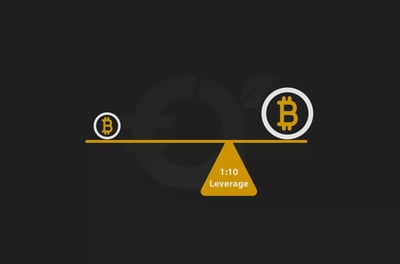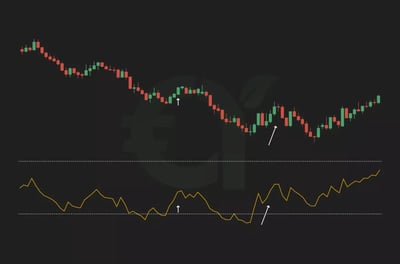Table Of Contents
- What Is Crypto Leverage Trading?
- How Does Crypto Leverage Trading Work?
- Pros and Cons of Crypto Leverage Trading
- 6 Crypto Leverage Trading Strategies
- 1. Range trading
- 2. Scalping
- 3. Gap trading
- 4. Trend trading
- 5. Breakout trading
- 6. Reversal trading
- General Advice for Crypto Leverage Trading
- The Bottom Line
6 Best Crypto Leverage Trading Strategies
In my trading career, I've found that using the power of leverage is an excellent way to supercharge your profits when trading cryptocurrencies. The practice of leverage trading is freely used by crypto traders today, but has its roots in older forms of trading, like FOREX. However, it is a high-risk exercise that carries the risk of significant losses if you do not use the right trading strategy and stick to it.
I learned that to use leverage, you must first understand the role of margin. Margin trading is often used interchangeably with leverage trading, but margin refers to the act of providing collateral to increase your purchasing power. With margin, you first deposit some of your own money into your account, and your broker tops it up with its own funds. Now that you have access to more capital and are using a combination of your own money and the broker’s money, you can use leverage. I've written this article to explain what leverage is and how to use it effectively.
Crypto leverage trading lets you control large positions with small capital by borrowing funds from your broker using margin.
Scalping is the most popular leveraged strategy in crypto and involves making many small trades in short bursts of high volatility.
Swing traders use lower leverage over longer timeframes, relying on fundamental analysis and clear market trends.
Popular strategies include range trading using support and resistance levels and breakout trading to catch new trends early.
Gap trading focuses on price moves that follow low activity periods, while trend and reversal trading rely on momentum shifts.
The biggest benefit of leverage is amplified profits, but it comes with the risk of equally large losses, especially for inexperienced traders.
Using demo accounts, goal setting, diversification, and limiting trade durations are practical ways to reduce the downside of leverage.
Regulations like the FCA cap leverage at 30:1 for retail traders to reduce risk, while some offshore brokers may allow up to 500:1.

What Is Crypto Leverage Trading?
It's almost inescapable that when trading, you will encounter leverage. It is the method by which traders can increase their market exposure by allowing them to pay a smaller amount than the full quantum of their investment. In simple terms, you are offered the facility to open trades many times the amount available in your account, as long as you first lodge an agreed amount of collateral or margin. This means that you only pay a percentage of the capital that sits in your account, allowing you to enter larger positions than you could on your own.
In crypto leverage trading, scalpers are the most prevalent trader type. Scalping is the practice of opening and closing multiple small trades in the same day to accumulate small profits that add up to a substantial total. Scalpers improve their earnings by using leverage in short bursts to get the best bang for their buck.
Another type of trading in the crypto world is swing trading. This form of trading is less common. Swing traders use leverage more sparingly and seek to profit over longer periods. They have done fundamental analysis and are confident that the market will swing in their favor over time.
By optimizing the relationship between exposure duration and leverage, a trader can achieve the best risk-to-reward ratio. For example, some scalpers trade at one-minute intervals in search of high volatility, which can be maximized with leverage as high as 1:200. Given crypto's high volatility, they have endless opportunities to capitalize on trades in short bursts, aided by high leverage.
In the opposite case, swing traders use low leverage over longer timeframes. They are taking a bet on an asset's long-term movement and therefore cannot afford for leverage to be too high if the trend does not go their way. Traders should remember that in the world of crypto, all cryptos are volatile, but not equally so. Bitcoin's normal volatility range differs from Ethereum's. This is where technical analysis enters, as it enables you to understand the resistance (upper) and support (lower) levels of the asset you are trading so you can make the most of them. This volatility is also why crypto is best suited to scalping rather than swing trading.

How Does Crypto Leverage Trading Work?
In my experience, leverage is closely linked to margin. As mentioned before, margin is where you, as the trader, put in a percentage of the total account value before you start trading. The broker matches the amount and effectively loans you a certain amount of their own money to increase your capital. You have now increased your buying power, and this means you can open larger positions than you could have on your own. Remember, though, that you can lose a lot of money on leverage, so you need to insert strong risk management guardrails into your trading strategies.
For example, let's say I wanted to invest $1,000 in a crypto with a leverage ratio of 10:1, the margin would be 10%, meaning I would need to invest $100. Now, consider if I wanted to perform the same trade on an unleveraged basis, I would have needed to come up with the full $1,000. This would have priced me out of the market. Remember, however, before you can start trading with the broker’s money as I did, you must lodge an amount of margin, or collateral. In the normal course of crypto leverage trading, if the broker determines that you are losing most of your money, it can issue a margin call, which is essentially taking ownership of your collateral because you are losing.
Pros and Cons of Crypto Leverage Trading
-
Bigger profits. With crypto leverage trading, you can make a lot of money quickly. Depending on the broker you use, you can utilize as much as 1:200 leverage, which, in the example we showed you above, is ample. However, there are brokers in less well-regulated markets where you can even trade as much as 1:500. Approach these with caution, as too much leverage in the wrong hands is a dangerous thing.
-
You can trade with less capital. This is a big win for those just starting. You don’t have to be highly capitalized to thrive in the crypto leverage trading space. If you do your research, come up with a strong strategy, and use a reputable broker that has a demo account facility, you could be successful with limited opening funds.
-
Added convenience. Trading of this type allows you to enter positions rapidly without having to make deposits of more funds to get to bigger position sizes. In a market where timing is vital, you will come to appreciate the level of convenience.
-
It teaches you discipline. You can learn the crucial trait of discipline as you manage your portfolio. Due to the speed and dynamic nature of leverage trading with crypto, the stakes are always high, and you must be on your game and highly disciplined.
-
You can diversify. You can easily diversify your portfolio if you have access to generous levels of leverage. You can create a thriving basket of different types of assets, meaning you can reduce the levels of risk on some assets as a hedge for the assets on which you use leverage more aggressively.
-
Bigger losses. On the opposite side of high profits come high losses. We should never forget that, in the world of trading, far more people lose money than they make money. Leverage, if not used responsibly, can lead to heavy losses. Therefore, many regulators take the burden of high leverage out of the hands of individual traders by capping leverage levels. For example, in the UK, the Financial Conduct Authority (FCA) mandates that leverage limits are now capped at 1:30, and trader positions must be closed out when the available capital drops to 50% of the margin requirements.
-
Higher risks. As mentioned, risk is part of the package with trading. If traders were able to trade in markets that were not leveraged and they had endless time to think and ponder their trades, they would be able to reduce much of the risk associated with trading. Truth be told, they would also reduce many of the rewards, too! While risk cannot be avoided, it must be managed well.
-
Tougher road for newcomers. The market is harder for new traders because everything moves so fast. There is a steep learning curve and some of the hardest lessons learned come when you lose money. So, while you don’t need much capital to start trading, losing your early capital is often a price you pay for inexperience and a lack of knowledge.
Recommended Brokers
6 Crypto Leverage Trading Strategies
In my experience, I've encountered many crypto trading strategies you can employ with leverage. Here are some of the most prominent:
1. Range trading
Range trading is a popular trading strategy whereby the trader identifies a range within which they will buy and sell. By conducting regular technical analysis using the charts patterns and channel analysis that most good brokers provide, a trader can tell the support and resistance levels within which an asset is trading.
Once you understand the movement of the asset within these bands, the next step is to identify a strategy that allows you to get the most out of trading in that range. You need to be aware of greater market rumblings that might shift these levels, but while trading within them, you can use a helpful tool like the moving average indicator to identify oversold or undersold zones.
2. Scalping
I have used this method to good effect. Scalping is both the name of trading strategy and the name of a trader who employs it. This popular intraday trading strategy is perfect for leverage trading cryptocurrencies. The idea behind scalping is to place very small trades that take advantage of minute price movements during a trading session. Scalpers make use of electronic communications network (ECN) infrastructure that is fast and reliable to scalp and accumulate profits. Scalpers can open and close hundreds of trades in a day and make a small amount each time (while losing out on their fair share of trades of course).
Scalpers must be disciplined and know to not deviate from their strategy as one wrong move chasing a larger profit could wipe out all the incremental gains they made on smaller trades. Scalpers use leverage, but not irresponsibly, because if they overcommit on a losing trade, they stand to lose a lot of money.
3. Gap trading
Markets are not made up of a constant and equal stream of trading activity. There are ebbs and flows governed by factors like the time of day or the day of the week that mean that sometimes trading gaps or lulls appear. Often, you will see a trading instrument’s price move sharply up or down as the market powers out of a trading gap. The movement could be downward or upward, and gap trading is the act of watching how these price gaps behave and seeking opportunities to profit from them.
4. Trend trading
With the computational power of modern tools, trend trading uses technical analysis to identify the direction of market momentum. Trend trading is less frenetic than intraday strategies like scalping and often spills over into swing trading, so it is a medium-term strategy. This trading strategy allows you to activate plans such as “catching the wave,” where you take advantage of an uptrend, or “buy the pullback,” which means you anticipate an asset falling back to a defined range. This is a highly technical trading approach that novices cannot readily use, as you need to be on top of your game with technical analysis.
5. Breakout trading
Also, utilizing trends, when you identify a breakout, you are identifying a new trend at the earliest possible moment. If you can capitalize on a new trend, you are breakout trading. One example with crypto could be when a new piece of legislation comes out in favor of crypto adoption, and you wait for the market to trend upward on positive sentiment. When you can reliably see that it is set to break out of its range, you can profit from this knowledge.
Breakout trading is used by day traders and swing traders alike, as there are often intraday breakouts, as well as longer-term breakouts. As you can appreciate, these strategies demand active participation in the market. To be effective at breakout trading, you must be able to intelligently analyze and survey the market in real time. This is where having a broker with the best technical tools and great analysis helps. One of the best ways to identify breakouts is to use Japanese candlesticks, powerful technical analysis tools that can be deployed on the platforms of many of the best brokers.
6. Reversal trading
Much of crypto volatility stems from price oscillating between support and resistance levels in response to price and volume movements, market trends, and sentiment. As surely as you know a market is moving in a particular direction, you will also know that it will reverse or pull back. This back-and-forth movement is simply the established order of things as markets dynamically respond to supply and demand forces. When you engage in reversal trading, you are simply taking advantage of an uptrend or downtrend that will inevitably reverse course.

General Advice for Crypto Leverage Trading
In the main, this is what I would say is the best advice for crypto leverage trading - you need to ensure that you develop good strategies and stick to them, and also:
Don’t overcommit on any single trade, no matter how much of a sure thing it appears to be.
Slowly increase your trade sizes. Remember I said there is a learning curve, don’t bet your house before you understand your broker’s platform and many of the terms and rules around crypto leverage trading.
Use a demo account. This is always a good idea. Why would you not practice in a no-risk environment when you would have more than enough risk by the time you enter the real world of trading? You can lose virtual money and be none the worse for it.
Set clearly defined goals. This practical advice is not always as attractive as the idea of making lavish profits, but being a successful trader is the product of making incremental improvements to your portfolio and your number of successful trades, as well as their value. So, you need to record and measure your successes and stick to clearly defined goals. We've written a detailed article on how to develop a trading plan to help you in this regard.
Divide your positions. As we discussed earlier, diversification is always best; it helps you avoid significant losses.
Limit the period of your trades. As we discussed, the merits of being in a trade for a short period apply when you are in a leveraged position; every second counts. As much as you think you may win, you can easily lose, so don’t dwell on any trade for too long.
The Bottom Line
In my view, getting better at leverage trading cryptocurrencies involves a steep learning curve. As a new trader, you will undoubtedly lose money in the beginning. This is true of virtually all newbies. The key to trading with leverage is not to let any of the lessons go to waste. Ensure that you track your progress and internalize the strategies we have discussed. Don’t overcommit yourself and be always aware of the pros and cons of this type of trading.






